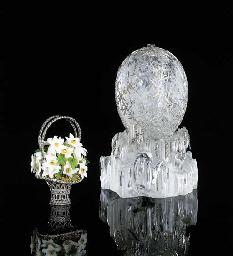Everybody knows the name Fabergé – the jewellery firm famous for making the jewel-encrusted easter eggs for the Russian Tsar and many other objects of superior quality and beauty for royal and other well-to-do buyers. But few people know that about 75% of the people who actually designed and made these objects were Finnish (many of them Finnish-Swedes). The most famous of them, Henrik Wigström was work headmaster for Fabergé from 1903 until the firm was nationalised by the Bolsheviks in 1918. Other famous Finnish workmasters were August Holmström and his son Albert, Anders Nevalainen, August Hollming and Hjalmar Armfelt.
Among all the great masters there was only one woman, the designer Alma Theresia Pihl, who was the daughter of the Finnish Fabergé workmaster Oskar Pihl. Among the objects the talented Pihl designed are two of the most famous Fabergé eggs; the “Mosaic Easter Egg ” (1914) now owned by Her Majesty, Queen Elizabeth II and the “Winter Egg” (1913).
In 2002 the Winter Egg was sold by Christie´s to an anonyous buyer for the not so modest sum, $9,579,500, the highest price ever paid for a Fabergé egg.
Christie´s did not fail to mention the designer in their information material for the sale:
The Winter Egg is without doubt one of the most creative and original of the Easter eggs Fabergé made for the Tsar. It symbolizes the transition from Winter to Spring, the seed emerging into new life, the Resurrection. The Spring flowers appear as if through a frosty mist inside the Winter ice of the egg, before the egg is opened to fully reveal the surprise. Only in the first Imperial Egg, the Hen Egg of 1885 (now in the Forbes Magazine Collection), has the Easter message so clearly illustrated, but does not have the degree of realism and delicacy achieved in the Winter Egg. Many of Fabergé's Imperial eggs rely on standard rococo and neo-classical motifs, albeit superbly executed in gold and enamel, for their effect, but Alma Theresia Pihl, the designer of the Winter Egg, broke away from these conventional elements to produce a magical work of original creative genius.
The Winter Egg was made in the workshop of Albert Holmström, which mainly specialized in jewelry. His father, August Holmström, had been appointed principal jeweler to the firm of Fabergé in 1857 and on his death in 1903, he was succeeded by his son. With the inspiration of the highly talented designer, Alma Theresia Pihl, whose two pièces de résistance were the Mosaic Egg, presented in 1914 (now in The Collection of Her Majesty The Queen of England) and The Winter Egg presented in 1913 and under the direction of Albert Holmström, some of Fabergé's most outstanding works were created.
If you are interested in acquiring an original Fabergé piece, the best place is certainly Wartski in London.( But you will need a heavy wallet!) The former owner and chairman of Wartski, Kenneth Snowman was also a great Fabergé scholar, whose books are a goldmine for those more seriously interested in exploring the world of Fabergé
PS
My own interest in Fabergé dates back to January 1994, when I saw the exhibition "Fabergé: Imperial Jeweller" at the Victoria and Albert Museum in London. It was the most beautiful exhibition that I have ever seen.

No comments:
Post a Comment